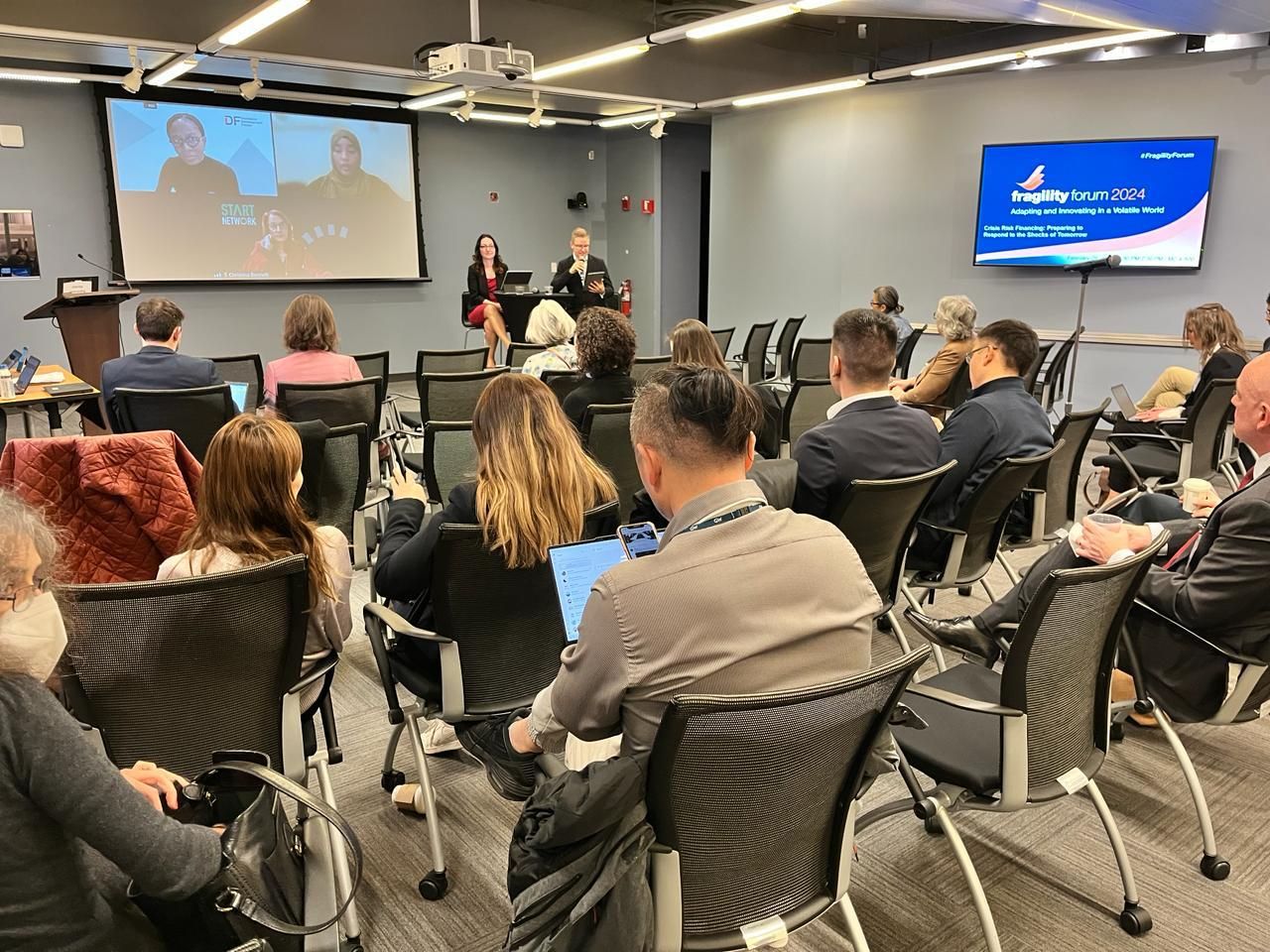[Fragility Forum 24 Event Recap] Crisis Risk Financing: Preparing to Respond to the Shocks of Tomorrow

The financial losses caused by climate crises and disasters are on the rise, creating significant fiscal risk and budget volatility. The World Bank Group (WBG)’s Crisis and Disaster Risk Finance (CDRF) in collaboration with Fragility, Conflict & Violence (FCV) conducted the session “Crisis Risk Financing: Preparing to Respond to the Shocks of Tomorrow,” on February 29, 2024, as a part of Fragility Forum 2024. Attended by 80+ participants (in-person and online), the session focused on the role of pre-arranged financing, different financial instruments, scaling up crisis risk financing, and the role of private sector financing. This event is part of an ongoing partnership between World Bank Group (WBG)’s Crisis and Disaster Risk Finance (CDRF) team with the Global Shield Financing Facility (GSFF), and Insurance Development Forum (IDF).
The panel comprised of Fardosa Abdullahi (Social Protection Policy Coordinator, Ministry of Labor, Somalia), Gallina A. Vincelette (Director for Operations Policy, World Bank), Ekhosuehi Iyahen (General Secretary, Insurance Development Forum), Lesley Ndlovu, (CEO, African Risk Capacity), and Christina Bennett (CEO, Start Network). Daniel Clarke (Director, Centre for Disaster Protection), who acted as moderator for the panel, opened the session by highlighting the challenges that FCV countries face in crisis financing and the role of pre-arranged financing in enabling improved responses to crises. He highlighted a recent study conducted by the Center for Disaster Protection, which found that prearranged finance is growing rapidly and, between 2017 to 2021, prearranged finance accounted for 2.2% of all crisis risk finance. However, prearranged finance accounted for only 0.2% of all crisis risk finance in FCV situations.
Gallina Vincelette provided valuable insights into the WBG’s new and enhanced Crisis Preparedness and Response Toolkit, which includes innovative instruments that provide options, enhanced flexibility, and the ability to work with countries so that they are well-prepared when a crisis hits. The toolkit helps countries to (i) scale up their contingent finance and preparedness by using instruments like Catastrophe Deferred Drawdown (Cat DDO) and newly introduced IPF (Investment Project Financing), (ii) enable client countries to repurpose a portion of their finance to crisis response, (iii) provide insurance against catastrophic events that is now included as a part of the toolkit, and (iv) introduce climate resilience debt clause for smaller countries wherein they can pause their debt payments up to two years in the event of a catastrophe. In her segment, Fardosa Abdullahi discussed the role of social protection in crisis response, focussing on the example of Somalia. She elaborated on the role of technology, particularly in the context of mobile payments to beneficiaries’ post crises, highlighting the unified registry that has been put in place in Somalia to aid crisis responses. Additionally, Fardosa stressed on the need to utilise early warning tools effectively to enable more effective pre-arranged financing. Along the same lines, Ekhosuehi Iyahen stressed on the need for enhanced engagement in development insurance, advocating for the implementation of risk layering and innovative instruments to improve accessibility. She emphasized the importance of accurate risk forecasting and understanding the evolution of risks to enhance response speed and efficiency. Christina Bennett presented on the need to evaluate impact when developing risk finance instruments, and the importance of working in close collaboration amongst all agencies to enable better unified response. Lesley Ndlovu emphasised the importance of having effective distribution mechanism in place and the key role of intermediaries, social protection groups, non-governmental organizations, and government agencies in the process.
The session concluded with an insightful Q&A segment, wherein panellists provided the participants with information about the applications of the different risk financing instruments.
Key takeaways:
- There is an urgent need to scale up prearranged finance, which currently accounts for 0.2% [1] of all the crisis risk finance in FCV situations.
- Innovative responses and comprehensive solutions to crisis, like the WBG’s enhanced Crisis Preparedness and Response Toolkit, comprising of a suite of financial solutions, including risk finance instruments, is essential to provide options, enhance flexibility, and the ability of a country to be prepared in face of crisis.
- There is a critical demand for stronger collaboration between Multilateral Development Banks (MDBs), Civil Society Organisations (CSOs) and the Private Sector.
To learn more about Disaster Risk Finance, please visit our portal Financial Protection Forum
Join the Disaster Risk Community of Practice and the Disaster Risk Finance Community @LinkedIn
For more information, please write to Kaavya Ashok Krishna (kashokkrishna@worldbank.org) or (drfip@worldbankgroup.org).
[1] This was part of the study conducted by the Center for Disaster Protection for the period of 2017- to 2021